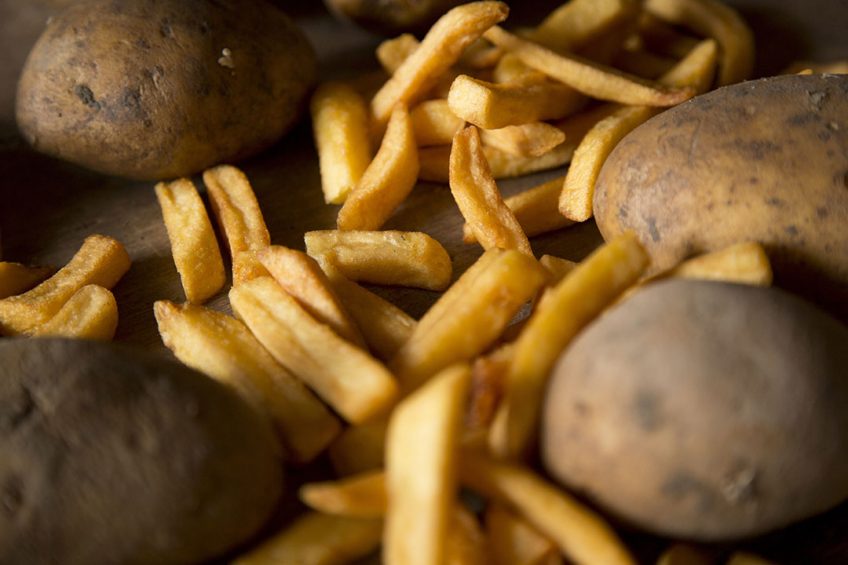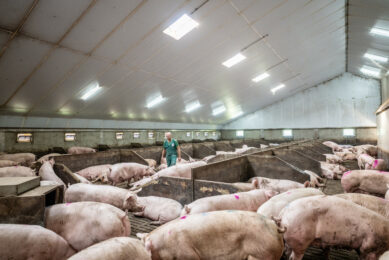Feeding by-products to pigs – how do the Dutch do it?

In the past, pigs were mainly fed leftovers from food or household production, to add value to by-products. On an industrial scale, well-organised and monitored, that is still happening in the Netherlands. Which are the most common by-products converted into pig feed?
These days, moist feeds are linked to the vicinity of industrial production of foodstuffs and ingredients from grain, potatoes, beets and seeds. After all, a large part of moist by-products finds its destination as a moist animal feed for pig and cattle farming. That, however, is not always the case. After all, another part of the moist secondary streams has other high-value applications in the pharmaceutical, food, feed, bio-ethanol and technical industries.
Manufacturers of moist animal feeds usually consider carefully which destination is the most interesting and sustainable for them. For example, moist by-products from the dairy butter and cheese industry are predominantly processed into new products. These days only a few percent of the original by-products will find their way to pig farming as moist ani-mal feed, while liquid whey and skimmed milk used to be an important source of protein for pig nutrition at the start of last century.
History
Wet products, derived from the preparation of foodstuffs, have always been used in livestock farming. Many centuries ago, that happened on a small scale on-farm or in the farm’s immediate vicinity. In that way, dairy farmers with their own cheese and butter production bought piglets on the pig markets in order to create added value to the skimmed milk and whey. These ingredients were mixed with grains and other suitable products from the farm, such as e.g. potatoes.
Another example are the cattle in the neighbourhood of Schiedam and Delft, in the west of the Netherlands, close to Rotterdam. Most of the Netherlands’ gin distilleries used to be located there. These distilleries usually have distillers grains as by-product of the alcohol preparation. For years, that product used to be supplied to farmers in the surroundings to feed their cattle.

Industrialisation
Times, however, have changed. Industrialisation of the food and ingredient sectors has become an ever-intensifying process. Dairy production was moved away from the farm to the dairy industry. As a result, the skimmed milk and whey were given higher value destinations, other than pig feed. At the moment only 2-3% of the original flow of whey and skimmed milk is sold as moist feed for pigs.
The development of industrialisation, however, also had another consequence, as new moist feeds have become available through the industrial production of food. The rise of the potato processing industry for the preparation of pre-fried chips and chips, for instance. In addition, starch and glucose production from corn and wheat have been introduced. These days, therefore, the basis of moist animal feeds for pig production in North West Europe is formed by products from wheat and potatoes.
The development of these industries has been so fast that there has been a true quest to find the right channels to sell the by-products. The destination was found in pig farming, which at that moment experienced rapid growth and was able to effortlessly absorb the increased production of wet feeds. Pig farming based on liquid feed has been developing so quickly that even products from Germany and Belgium are also being used intensively in Dutch pig farming.
Moist animal feeds 2018
The most important moist animal feeds for pigs are heat-treated potato products; wheat starch slurry and wet distillers grains; and whey from the dairy industry – see below for more detail. Every year about 3 million tonnes of moist animal feed are being sold to pig farming. This leads to approximately 30% of the Dutch pigs being fed wet feeds.
Often, it is said that liquid feed leads to slightly better results than conventional feed as the feed has been prefermented and has been acidified due to the growth of lactic acid bacteria, which would lead to a better pig health. In addition, pigs on liquid feed usually are known to deal better with phosphorus in the feed.
It is good to mention that a large proportion of the available moist animal feed is intended for sale to ruminants. This is approximately 2.5 million tonnes annually. The main products there are beet pulp, potato products, beer broth and corn gluten feed. Below is a summary of the most important products for pig farming.
 Potato steam peelings
Potato steam peelings
A lot of steam and heat is used for processing potatoes. All steamed and heat-treated products from the potato can be used in pig nutrition. This quantity has increased in recent years due to the expansion of French fries production in the Netherlands and Belgium. The most important product for pig farming is the steamed potato peelings and other steamed parts of the potato.
 Wheat starch slurry and wet distillers grains
Wheat starch slurry and wet distillers grains
In specialised factories, starch is extracted from wheat through a wet process. Not all starch is suitable for use in the manufacturing or food industries. Part of that production stream is deposited as ‘slurry’, which is extremely suitable for pig farming. The product can replace grains in pig rations.
In recent years. an important part of this liquid flow has been used for the production of bioethanol. Bioethanol can also be produced from whole grain. When mainly wheat is used for the production of ethanol, a liquid feed is also produced. This product is sold to pig and cattle farming. In the Netherlands, the most important part is sold to pig farming as a high-
quality protein source.
 Whey
Whey
Whey products are still being fed to pigs. Usually it is produced in smaller cheese factories or these products are produced from the preparation of other high quality dairy products. In contrast to whey and skim milk, the products are low in protein and contain more minerals.
Animal feed: not a given
Food and ingredient producers continuously look for innovation. Those companies usually like to find the most sustainable destination for the products they produce. Commonly, that coincides with the destination which offers the highest added value. Animal feed may be an important destination, new applications, however, such as food, industrial and pharmaceutical applications are also still being developed. All of these are also sustainable applications, just like using it for animal feed.











